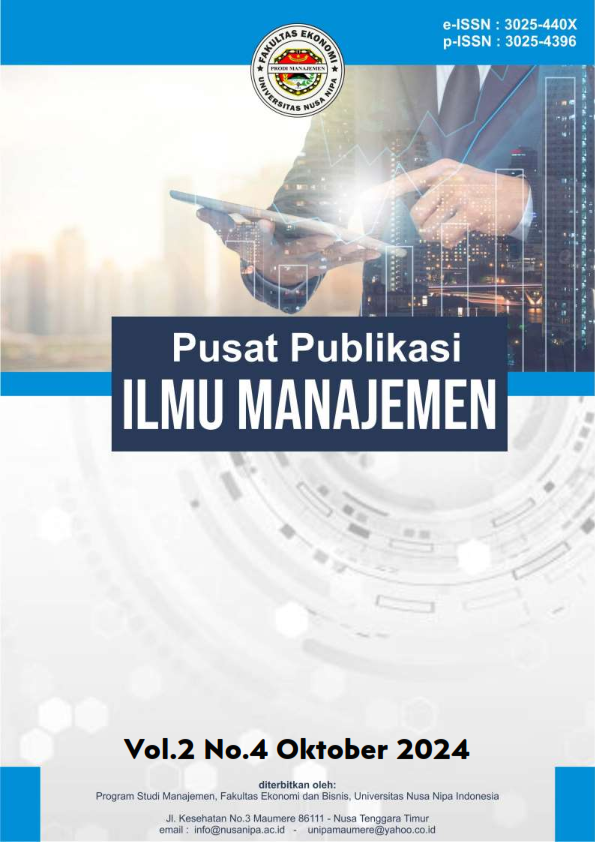Pengaruh Campaigns terhadap Brand Jiniso.id yang di Endorsement untuk Kalangan Post-Millennials pada Sosial Media Instagram
DOI:
https://doi.org/10.59603/ppiman.v2i4.534Keywords:
Instagram Social Media, Post-Millennials, Brand Familiarity, Campaign Fit, Campaign Credibility, Campaign Attitude, Brand Experiences, Brand AttitudeAbstract
In today's digital era, social media has an important role in everyday life, one of which is as a communication channel. This research investigates the impact of brand familiarity, campaigns and brand experiences on brand attitude. This research is a quantitative approach and uses Structural Equation Modeling (SEM-PLS) analysis. The population in this study is the post-millennial generation who are active users of Instagram social media, have used or purchased Jiniso brand jeans fashion products, and live in the Jabodetabek area. This research uses a non-probability sampling method with a purposive sampling technique with a sample size of 182 respondents. Based on the research results, of the 7 hypotheses there are 5 hypotheses that are accepted, namely brand familiarity has a positive effect on campaign credibility, campaign fit has a positive effect on campaign credibility, campaign credibility has a positive effect on campaign attitude, campaign attitude has a positive effect on brand attitude, and brand experience has a positive effect on brand attitude. There are 2 hypotheses that were rejected, namely brand familiarity has no effect on brand attitude and involvement with the cause has no effect on campaign attitude. Based on these results, Jiniso is advised to improve and strengthen campaign strategies and marketing methods that can enable post-millennials to increasingly talk about their products on digital media.
References
Acharya, A. (2021). The impact of brand familiarity, customer brand engagement and self-identification on word-of-mouth. South Asian Journal of Business Studies, 10(1), 29–48. https://doi.org/10.1108/SAJBS-07-2019-0126
Acquisti, A., & Gross, R. (2006). Imagined communities: Awareness, information sharing, and privacy on Facebook. In Lecture Notes in Computer Science (Vol. 4258). https://doi.org/10.1007/11957454_3
Adiyono, N. G., Rahmat, T. Y., & Anindita, R. (2021). Digital marketing strategies to increase online business sales through social media. Journal of Humanities, Social Science, Public Administration and Management (HUSOCPUMENT), 1(2), 31–37. https://doi.org/10.51715/husocpument.v1i2.58
Aggarwal, V., & Singh, V. K. (2019). Cause-related marketing and start-ups: Moderating role of cause involvement. Journal of Global Responsibility, 10, 16–30. https://doi.org/10.1108/JGR-08-2018-0034
Allende, E. (2018). Jóvenes y hábitos de consumo en turismo. Revista de Estudios de Juventud, Marzo(119), 47–61. http://www.injuve.es/sites/default/files/2018/41/publicaciones/3.-_jovenes_y_habitos_de_consumo_en_turismo.pdf
Altriana, M. (2019). Pengaruh kredibilitas perusahaan dan kredibilitas endorser pada sikap konsumen (terhadap iklan dan merek) dan intensi membeli. Jurnal Online Internasional & Nasional, 7(1), 53(9), 1689–1699. https://www.journal.uta45jakarta.ac.id
Amaldi, D., Sugita, B., & Sihombing, S. (2021). Predicting the relationship between perceived influence, brand engagement, brand expected value and intention to purchase: An empirical study. Jurnal Manajemen Terapan dan Keuangan, 10, 42–52. https://doi.org/10.22437/jmk.v10i01.9263
Angermeyer, M., & Dietrich, S. (2006). Public beliefs about and attitudes towards people with mental illness: A review of population studies. Acta Psychiatrica Scandinavica, 113, 163–179. https://doi.org/10.1111/j.1600-0447.2005.00699.x
Aprillian, V., & Nurhasanah, N. (2023). Peran perceived influencer terhadap intention to purchase recommended brands. Jurnal Publikasi Ilmu Manajemen (JUPIMAN), 2(4), 388–400. https://doi.org/10.55606/jupiman.v2i4.2841
Badri, M. (2019). Adoption of innovation online transportation application in post-millennial generation in Pekanbaru City. Jurnal Penelitian Komunikasi dan Opini Publik, 23(2). https://doi.org/10.33299/jpkop.23.2.2320
Başgöze, P., & Özer, L. (2012). Effects of brand credibility on technology acceptance model: Adaption of the model to the purchase intention. International Journal of Humanities and Social Science, 2(20), 292–298.
Borghini, S., Diamond, N., Kozinets, R. V., McGrath, M. A., Muñiz, A. M., & Sherry, J. F. (2009). Why are themed brandstores so powerful? Retail brand ideology at American Girl Place. Journal of Retailing, 85(3), 363–375. https://doi.org/10.1016/j.jretai.2009.05.003
Buil, I., Martínez, E., & Montaner, T. (2012). La influencia de las acciones de marketing con causa en la actitud hacia la marca. Cuadernos de Economía y Dirección de la Empresa, 15(2), 84–93. https://doi.org/10.1016/j.cede.2012.01.002
Chang, C.-T., Chu, X.-Y., & Tsai, I.-T. (2021). How cause marketing campaign factors affect attitudes and purchase intention: Choosing the right mix of product and cause types with time duration. Journal of Advertising Research, 65, 58–77. https://doi.org/10.2501/JAR-2019-046
Cohen, & Prusak. (2001). The impact of organisational justice on ethical behaviour. International Journal of Business Innovation and Research, 12, 240. https://doi.org/10.1504/IJBIR.2017.10001664
Correa, E. A. J., Palacio-López, S. M., Sánchez-Torres, J. A., Martínez, L. F. G., Zapata, J. P. A., Fernández, Y. L. H., & Lopera, C. P. (2021). Effectiveness of social responsibility marketing in young millennials - generation Y: Analysis of three cases for brand positioning. Heliyon, 7(10). https://doi.org/10.1016/j.heliyon.2021.e08150
Damayanti, R., Komariah, K., Muhammadiyah, U., & Sukabumi, K. (2022). Analysis of brand awareness and advertising attractiveness on brand attitude cosmetics Wardah during the Covid-19 pandemic. Management Studies and Entrepreneurship Journal, 3(4), 2098–2106. http://journal.yrpipku.com/index.php/msej
Dimock, M. (2018). Defining generations: Where Millennials end and post-Millennials begin. Pew Research Center, 6–9. https://fbuxconsulting.com/wp-content/uploads/2019/05/Where-Millennials-end-and-post-Millennials-begin-_-Pew-Research-Center-1.pdf
Djafarova, E., & Rushworth, C. (2017). Exploring the credibility of online celebrities’ Instagram profiles in influencing the purchase decisions of young female users. Computers in Human Behavior, 68, 1–7. https://doi.org/10.1016/j.chb.2016.11.009
Dolbec, P. Y., & Chebat, J. C. (2013). The impact of a flagship vs. a brand store on brand attitude, brand attachment and brand equity. Journal of Retailing, 89(4), 460–466. https://doi.org/10.1016/j.jretai.2013.06.003
Duarte, P., & Silva, S. (2018). The role of consumer-cause identification and attitude in the intention to purchase cause-related products. International Marketing Review. https://doi.org/10.1108/IMR-04-2018-0159
Eastman, J. K., Iyer, R., & Thomas, S. P. (2013). The impact of status consumption on shopping styles: An exploratory look at the millennial generation. Marketing Management Journal, 23(1), 57–73. http://search.ebscohost.com/login.aspx?direct=true&db=buh&AN=93686709&site=ehost-live&scope=site
Eastman, J., & Liu, J. (2012). The impact of generational cohorts on status consumption: An exploratory look at generational cohort and demographics on status consumption. Journal of Consumer Marketing, 29. https://doi.org/10.1108/07363761211206348
Ellison, N. B. (2007). The benefits of Facebook ‘friends’: Social capital and college students’ use of online social network sites. Journal of Computer-Mediated Communication, 12(4), 1143–1168. https://doi.org/10.1111/j.1083-6101.2007.00367.x
Additional Files
Published
How to Cite
Issue
Section
License
Copyright (c) 2024 PPIMAN Pusat Publikasi Ilmu Manajemen

This work is licensed under a Creative Commons Attribution-ShareAlike 4.0 International License.






